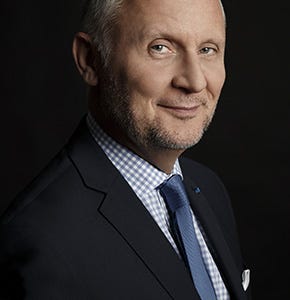Orange pledges €15bn FTTH and LTE investment by 2018Orange pledges €15bn FTTH and LTE investment by 2018
Orange has pledged to spend more than €15bn on upgrading fixed and mobile infrastructure across Europe, and says there’s still “so much more to come” from LTE, according to Deputy CEO Gervais Pellissier.
March 2, 2016

Orange has pledged to spend more than €15bn on upgrading fixed and mobile infrastructure across Europe, and says there’s still “so much more to come” from LTE, according to Deputy CEO Gervais Pellissier.
The operator has taken a leading role in FTTH rollouts across the continent, and claims to have already connected nearly 2 million homes to date. The main regions the operator has focused on thus far include home market France, with Spain being its second-largest market and one with a growing emphasis following its acquisition of triple-play operator Jazztel – which operates a well-established fibre optic broadband service and infrastructure.
 According to Deputy CEO Pellissier (right), network infrastructure investment and fixed/mobile convergence are two of the biggest trends the telco is focussing on across Europe over the coming five years. Laying the foundation for next generation infrastructure will be one of the principle enablers of bringing in the era of 5G, Pellissier says. Before that happens, however, the operator needs to focus on maximising the network’s capability to guarantee the optimal customer experience.
According to Deputy CEO Pellissier (right), network infrastructure investment and fixed/mobile convergence are two of the biggest trends the telco is focussing on across Europe over the coming five years. Laying the foundation for next generation infrastructure will be one of the principle enablers of bringing in the era of 5G, Pellissier says. Before that happens, however, the operator needs to focus on maximising the network’s capability to guarantee the optimal customer experience.
Indeed, the focus on network infrastructure is not insignificant. Orange has committed to $15bn in CAPEX-based network investment, $5bn of which is reserved exclusively for fibre, with the remaining $10bn going into the mobile core.
As a case in point, the investment in Spanish fibre infrastructure has seen a drive in fixed customer ARPU. Pellissier says this is down to the increased availability and quality of video content being streamed over fibre networks.
“The biggest trend we’ve seen is in Spain, where there’s been an APRU increase of €3-5 per month,” says Pellissier. “This is down to the new technology but also because of new content. When you deliver FTTH, the main use is video and in Spain we’ve had a rapid increase in the number of TV customers on our network. At the end of 2014 we had 120,000 TV subscribers which is less than 10% of our broadband base; but at the end of 2015 we multiplied that by more than three, more than 400,000 customers. By the end of 2018 we see more than 50% TV penetration on our broadband customer base in Spain.
“Spain’s growing very fast for us. By the end of 2016 we think satellite distribution of TV for us will have almost disappeared, it will be all-IP or cable. In 2013, Pay-TV on satellite was 80%; and we expect this to reverse by the end of this year, with fibre and IP taking its place. 4K is a massive driver for this, and also the consumer trends for consuming TV is completely different now. Only 20% of millennials in Spain watch regular scheduled TV, on-demand streaming has taken its place.”
Telecoms.com spoke with Pellissier at Mobile World Congress 2016 in Barcelona, where he also stressed the importance of maximising the potential of LTE network infrastructure to both emerging and well-established mobile markets across Europe.
“No, LTE has not reached its full potential yet,” he said when asked about the potential LTE still has in its locker. “There are two reasons for this. Firstly, we are just starting to deploy new spectrum bands in a few countries, so additional LTE coverage and speed is coming. We still see, in terms of capacity and potential, three or four of capacity for deployment and real-use. There’s still a huge opportunity for 4G-capable smartphone penetration, in France alone it’s only at around 25%. And that’s without even mentioning VoLTE and VoWifi, which are both coming this year in Spain, France, Belgium, Poland and Romania.”
Gervais concluded by promising a heavy focus on maximising LTE investment over the coming years, given the vast opportunity that still exists for operators managing 4G networks. “There’s so much more to come from LTE,” he said. “There are 100 million mobile subscribers in Europe, around 18 million of which are on Orange 4G as of the end of 2015 – we’ve got a lot of work left to do.”
About the Author
You May Also Like










.png?width=300&auto=webp&quality=80&disable=upscale)


_1.jpg?width=300&auto=webp&quality=80&disable=upscale)